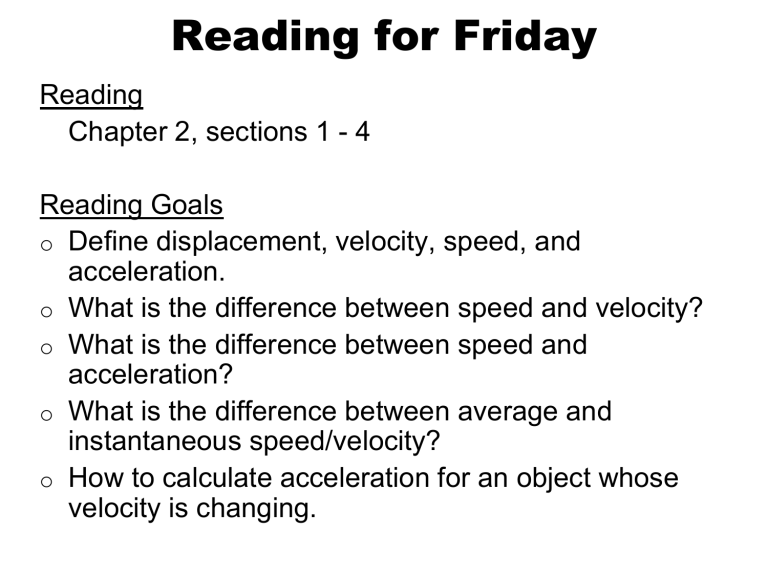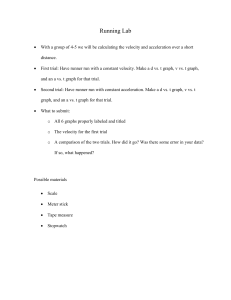
Reading for Friday Reading o Chapter 2, sections 1 - 4 Reading Goals o Define displacement, velocity, speed, and acceleration. o What is the difference between speed and velocity? o What is the difference between speed and acceleration? o What is the difference between average and instantaneous speed/velocity? o How to calculate acceleration for an object whose velocity is changing. MasteringPhysics HW 1: Units (due 09/06) Velocity pre-lecture video (due 09/01) Estimate the number of dentists in New York City. Population of NYC ~ 10 million How often does the average person see a dentist every year? ~ 1 10 million patient visits/year How much time do they spend with the dentist? ~ 30 minutes A dentist sees ~100 patients per week or 5000 patients/year 10 million patient visits / 5000 patients/dentist = 2000 dentists Calculations with Significant figures Significant figures are a measure of precision. Adding and Subtracting – Use the smallest number of decimal places. Multiplying and Dividing - Use the smallest number of significant figures. Examples: 16,584 m + 8.3 m = 16,584 m × 8.3 m = Express the sum of 248915 m + 13.97 m using the proper number of significant figures. Express the product of 248915 m + 13.97 m using the proper number of significant figures. Metric mishap caused loss of NASA orbiter September 23, 1999 NASA lost the $125 million Mars Climate Orbiter because a Lockheed Martin engineering team used English units of measurement while NASA used the more conventional metric system for a key spacecraft operation. After a 286-day journey, the probe fired its engine to push itself into orbit. A piece of ground software supplied by Lockheed Martin produced results in English units (pound•seconds), while a second system, supplied by NASA, expected those results to be in SI units (Newton•seconds). Due to the discrepancy, the climate Orbiter likely either burned up the atmosphere or continued out beyond Mars and is now orbiting the sun. http://www.cnn.com/TECH/space/9909/30/mars.metric.02/ SI Units (the Metric System) Base units: Length – meter (m) Mass – kilogram (kg) Time – second (s) MKS system: Most other units derived from these 3 Examples: o velocity (m/s) o acceleration (m/s2) o force (N or kg·m/s2) Table 1-4 Know these 1 km = 1000 m 1 cm = 0.01 m 1 mm = 0.001 m Unit Conversion Express 8432 m in kilometers. Conversion factor: 1000 m = 1 km Unit Conversion Express 8432 m in kilometers. Conversion factor: 1000 m = 1 km To convert 8432 m to km, multiply by the conversion factor expressed as a fraction: 1 km 1= 1000 m Unit Conversion Express 8432 m in kilometers. 8432 m × 1 km 1000 m = 8.432 km Unit Conversion How fast is 60.0 miles per hour (mph) in meters per second (m/s)? Given 1 mile = 1.609 km 1 km = 1000 m Unit Conversion How fast is 60.0 miles per hour (mph) in meters per second (m/s)? Given 1 mile = 1.609 km 1 km = 1000 m Answer: 26.8 m/s Unit conversions are on the inside front cover of your textbook. For more help with units conversions: http://www.youtube.com/watch?v=lAan6L9UjsE




